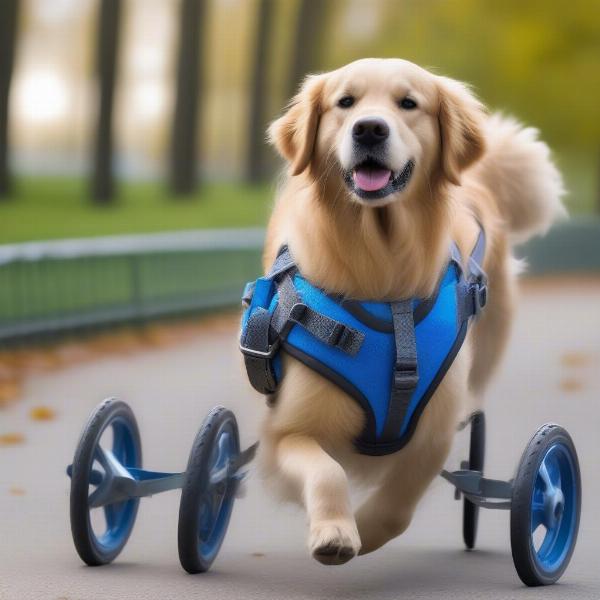Dogs with wheels, also known as dog wheelchairs or carts, are mobility aids that allow disabled dogs to walk and run again. These devices can dramatically improve the quality of life for dogs suffering from a range of mobility issues, from hip dysplasia and arthritis to paralysis and spinal injuries. Whether your furry friend is a senior struggling with age-related mobility decline or a younger dog facing a physical challenge, dog wheelchairs can offer newfound freedom and independence.
 Dog happily walking in the park using a wheelchair
Dog happily walking in the park using a wheelchair
Understanding the Need for Dog Wheelchairs
Why might a dog need wheels? A variety of conditions can lead to mobility impairment in dogs. Some of the most common reasons include:
- Intervertebral Disc Disease (IVDD): This condition affects the spinal discs, often leading to pain, weakness, and paralysis.
- Hip Dysplasia: This genetic condition causes the hip joint to develop abnormally, resulting in pain and difficulty walking.
- Arthritis: As dogs age, arthritis can cause joint pain and stiffness, hindering their mobility.
- Degenerative Myelopathy (DM): A progressive disease of the spinal cord, DM gradually leads to weakness and paralysis in the hind limbs.
- Injuries: Accidents or trauma can result in injuries that impair a dog’s ability to walk.
- Neurological Conditions: Certain neurological conditions can affect a dog’s coordination and mobility.
Choosing the Right Dog Wheelchair
Selecting the correct wheelchair for your dog is crucial for its comfort and effectiveness. Consider the following factors:
- Size and Breed: Wheelchairs are designed to accommodate different sizes and breeds, from tiny Chihuahuas to giant Great Danes. Accurate measurements are essential for a proper fit.
- Type of Disability: The type and severity of your dog’s disability will influence the type of wheelchair required. Some wheelchairs support only the hind legs, while others support all four limbs.
- Adjustability: Look for wheelchairs with adjustable features, such as height, length, and width, to ensure a comfortable and secure fit as your dog’s needs change.
- Material and Durability: Opt for a durable and lightweight material, such as aluminum or stainless steel, that can withstand regular use.
- rear leg wheels for dogs This article provides detailed information specifically about rear leg wheelchairs for dogs.
Getting Your Dog Used to Its Wheelchair
Introducing a wheelchair to your dog should be a gradual and positive experience. Start by letting your dog sniff and investigate the wheelchair. Then, gently introduce the harness and allow your dog to wear it for short periods, gradually increasing the duration. Reward your dog with treats and praise throughout the process. Once your dog is comfortable with the harness, attach the wheels and encourage short walks, gradually increasing the distance and duration.
Benefits of Dog Wheelchairs
- Increased Mobility and Independence: Wheelchairs allow disabled dogs to regain their mobility and explore the world around them.
- Improved Physical and Mental Health: Exercise and stimulation are crucial for both physical and mental well-being. Wheelchairs allow disabled dogs to engage in physical activity, reducing muscle atrophy and improving their overall mood.
- dog with wheels toy Find toys suitable for dogs with mobility limitations.
- Enhanced Quality of Life: By restoring mobility and independence, wheelchairs can significantly enhance a dog’s overall quality of life.
Maintaining Your Dog’s Wheelchair
Regular maintenance is essential to ensure the longevity and effectiveness of your dog’s wheelchair. Check the wheels, tires, and frame regularly for any signs of wear and tear. Clean the wheelchair regularly to prevent the buildup of dirt and debris. dog carrier on wheels provides more options for mobility solutions.
Conclusion
Dog wheelchairs can be life-changing for disabled dogs, providing them with a renewed sense of freedom and independence. By carefully selecting the right wheelchair, introducing it gradually, and providing ongoing support, you can help your furry friend live a happy, active, and fulfilling life, even with mobility challenges. dog crate on wheels offers convenient and safe transport solutions for dogs.
FAQ
- How long does it take for a dog to get used to a wheelchair? It varies from dog to dog, but most dogs adapt within a few days to a few weeks.
- Can dogs with wheelchairs still go to the bathroom? Yes, most wheelchairs are designed to allow dogs to relieve themselves comfortably.
- Are dog wheelchairs expensive? The cost varies depending on the size, features, and brand. dog carrier airline approved with wheels can be helpful for travelling.
- What are the different types of dog wheelchairs available? There are two main types: rear support and full support (for all four legs).
- Can my dog sleep in its wheelchair? It’s generally not recommended for dogs to sleep in their wheelchairs.
ILM Dog is your trusted partner in providing the best care for your canine companion. We offer expert advice and resources on all aspects of dog care, from breed selection and health to training and nutrition. Whether you’re a first-time dog owner or a seasoned expert, we’re here to help you navigate every step of your dog’s journey. Our services include guidance on choosing the right breed, understanding your dog’s health needs, providing training and behavioral support, and recommending appropriate nutrition and grooming practices. For personalized advice and support, contact us today. Email: [email protected], Phone: +44 20-3965-8624. Visit ILM Dog for a wealth of information and resources to help you provide the best possible care for your furry friend.